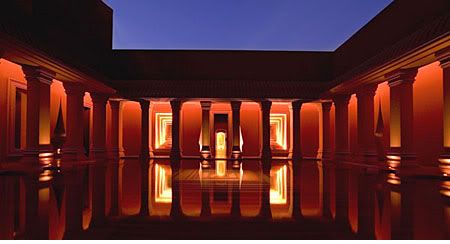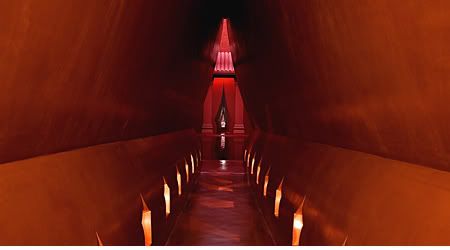
"Barai" comes from the word baray which is a large man made reservoir created by the ancient Khmers to channel irrigated water for use in their daily lives. In that era the baray was an important source of life that brought happiness, well-being and peace to the people.
Design team: Mathar “Lek” Bunnag of Bunnag Architects
Location: 91 Hua Hin - Khao Takiap Road, Hua Hin, 77110, Thailand
Cost: US $12,000,000
When to visit: now
THE BARAI is a journey where the art of the architecture is your guide. Designed by the renowned Thai architect and interior designer, Lek Bunnag, THE BARAI is inspired by the heritage of Khmer architecture from the 11th century. The architecture and interior design of THE BARAI represents the glory of Khmer style of art, combined with the heritage of other art styles from this region. This will be reflected not only in the grandeur of the main facilities and in each of the treatment rooms, but also in all aspects of THE BARAI experience. The BARAI design elements include a wall designed to capture the sunset, a playful nod to Apsaras, a nymph-like creature in Hindu and Buddhist lore, and a swimming channel.


Surrounded by the pink exterior, The Barai Residences, an eight suite hotel and spa, ranging in size from 125 square metres to 150 square metres, are designed for treatments and overnight stays. The Barai Residences on the ground floor feature a verandah with a private plunge pool and garden, while those on the upper floor have spacious balconies and spectacular views of the Gulf of Thailand.




THE BARAI will also have 18 private treatment suites. Each suite features a private outdoor soaking pool, rain shower, Thai bed area for relaxation and Thai traditional treatments, private changing room and vanity. Three double suites offer deluxe hydrotherapy treatments with addition of Vichy treatment room and steam room.





The Barai journey begins in the car park, with a series of stepping stones leading to the welcome gallery artfully designed to slow guests down, but guests are formally welcomed in the Salarai water court, designed to recall a baray. The next stop is the Wall of Stars, a waiting area which uses cut-outs to capture light in constellation-like patterns--most resonating in the moments before sunset.Apsaras is realized in accents throughout the grounds. In washrooms, guests peer into her eyes, in the form of mirrors. Her presence is felt again in the treatment room, where fleeting glimpses of her hair, ears, and clothing hems are reinterpretedin mediums including sculpture. On the grounds, the design naturally progresses to the coast. Recognizing the natural beauty of existing trees, Bunnag designed the swimming channel to twist around them--instead of chopping them down--before leading to the sea.

McFarland House. An existing two-storey pavilion dating back to the 19th Century has been restored and transformed into an airy and elegant beachfront casual dining area offering a unique dining experience overlooking the Gulf of Thailand.



Court of Tranquillity. This secluded place of tranquillity with swimming channel and sand court is a perfect place for relaxation, yoga and meditation sessions.









via The Barai
Photo credits: Martin Nicholas Kunz
No comments:
Post a Comment